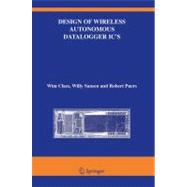
Note: Supplemental materials are not guaranteed with Rental or Used book purchases.
Purchase Benefits
What is included with this book?
| Abstract | v | ||||
| List of Abbreviations and Symbols | vii | ||||
| Table of Contents | xiii | ||||
| 1 Introduction | 1 | (2) | |||
| 2 General design aspects of miniaturized low-power dataloggers | 3 | (24) | |||
|
3 | (1) | |||
|
4 | (1) | |||
|
5 | (10) | |||
|
6 | (1) | |||
|
7 | (3) | |||
|
10 | (1) | |||
|
11 | (1) | |||
|
12 | (1) | |||
|
13 | (1) | |||
|
13 | (2) | |||
|
15 | (8) | |||
|
15 | (4) | |||
|
15 | (1) | |||
|
15 | (2) | |||
|
17 | (2) | |||
|
19 | (37) | |||
|
19 | (1) | |||
|
20 | (1) | |||
|
21 | (2) | |||
|
23 | (4) | |||
| 3 Miniaturized datalogger for stress monitoring in oral implants | 27 | (26) | |||
|
27 | (1) | |||
|
27 | (5) | |||
|
32 | (7) | |||
|
39 | (2) | |||
|
41 | (6) | |||
|
47 | (3) | |||
|
50 | (3) | |||
| 4 Multi-gauge offset-compensated sensor interface chip | 53 | (82) | |||
|
53 | (1) | |||
|
53 | (3) | |||
|
56 | (68) | |||
|
56 | (9) | |||
|
56 | (2) | |||
|
58 | (1) | |||
|
59 | (2) | |||
|
61 | (2) | |||
|
63 | (2) | |||
|
65 | (9) | |||
|
65 | (3) | |||
|
68 | (5) | |||
|
73 | (1) | |||
|
74 | (3) | |||
|
74 | (3) | |||
|
77 | (1) | |||
|
77 | (24) | |||
|
77 | (3) | |||
|
80 | (1) | |||
|
81 | (2) | |||
|
83 | (5) | |||
|
88 | (2) | |||
|
90 | (2) | |||
|
92 | (3) | |||
|
95 | (3) | |||
|
98 | (3) | |||
|
101 | (5) | |||
|
101 | (1) | |||
|
102 | (1) | |||
|
103 | (2) | |||
|
105 | (1) | |||
|
106 | (14) | |||
|
106 | (2) | |||
|
108 | (3) | |||
|
111 | (2) | |||
|
113 | (2) | |||
|
115 | (3) | |||
|
118 | (2) | |||
|
120 | (5) | |||
|
120 | (2) | |||
|
122 | (2) | |||
|
124 | (1) | |||
|
125 | (6) | |||
|
125 | (2) | |||
|
127 | (1) | |||
|
127 | (2) | |||
|
129 | (1) | |||
|
129 | (1) | |||
|
130 | (1) | |||
|
131 | (4) | |||
| 5 Intelligent-datalogger IC with programmable data processing | 135 | (32) | |||
|
135 | (1) | |||
|
135 | (2) | |||
|
135 | (1) | |||
|
136 | (1) | |||
|
137 | (2) | |||
|
139 | (3) | |||
|
142 | (2) | |||
|
144 | (14) | |||
|
144 | (2) | |||
|
146 | (4) | |||
|
150 | (1) | |||
|
151 | (7) | |||
|
158 | (2) | |||
|
160 | (4) | |||
|
164 | (1) | |||
|
164 | (3) | |||
| 6 Conclusion | 167 | (4) | |||
| A Transistor dimensions | 171 | (6) | |||
| B Digital error correction of ADC | 177 | (2) | |||
| C Sampling unit | 179 | (8) | |||
|
179 | (6) | |||
|
185 | (2) | |||
| List of Publications | 187 | (2) | |||
| Bibliography | 189 | (8) | |||
| Index | 197 |
The New copy of this book will include any supplemental materials advertised. Please check the title of the book to determine if it should include any access cards, study guides, lab manuals, CDs, etc.
The Used, Rental and eBook copies of this book are not guaranteed to include any supplemental materials. Typically, only the book itself is included. This is true even if the title states it includes any access cards, study guides, lab manuals, CDs, etc.